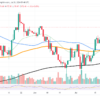
There has been a notable development in the Bitcoin (BTC) ecosystem, potentially signaling a significant change in asset availability and market perception. Nic Puckrin, the renowned CEO of Coin Bureau, recently highlighted a phenomenon in the Bitcoin market that could indicate an early supply shock, which was previously expected to occur after the halving.
There has been a notable development in the Bitcoin (BTC) ecosystem, potentially signaling a significant change in asset availability and market perception. Nic Puckrin, the renowned CEO of Coin Bureau, recently highlighted a phenomenon in the Bitcoin market that could indicate an early supply shock, which was previously expected to occur after the halving.
Puckrin’s observations, shared on According to the data he shared, there has been a cumulative net inflow of approximately 180,000 BTC into the US. detect Bitcoin ETFa figure significantly higher than the 55,000 BTC that was mined during the same period.
Bitcoin Price Impact
This discrepancy underscores a tightening of the supply of Bitcoin available on the market, leading to what is commonly known as a “supply shock.” The accompanying chart clearly shows the growing gap between ETF inflows and the amount of Bitcoin mined since early January 2024.
This trend is particularly notable as it occurs ahead of Bitcoin’s next halving event, a periodic event that halves the reward for mining new blocks, effectively slowing the rate at which new coins are created. Historically, halving events have been associated with price increase market volatility and anticipation.
These developments indicate strong market sentiment towards Bitcoin, as the growing participation of institutional investors through products such as ETFs has significantly influenced the supply and demand dynamics of BTC. Furthermore, the upcoming halving event is likely to accentuate this supply shock, which could further impact the price of Bitcoin.
As of the last update, the price of Bitcoin it’s found to $73,238, showing a marginal decrease of 0.03% in the last 24 hours. However, this slight drop contrasts with solid growth of 45.97% over the past month, reinforcing the volatile nature of the asset and its susceptibility to market dynamics such as supply and demand shifts.























